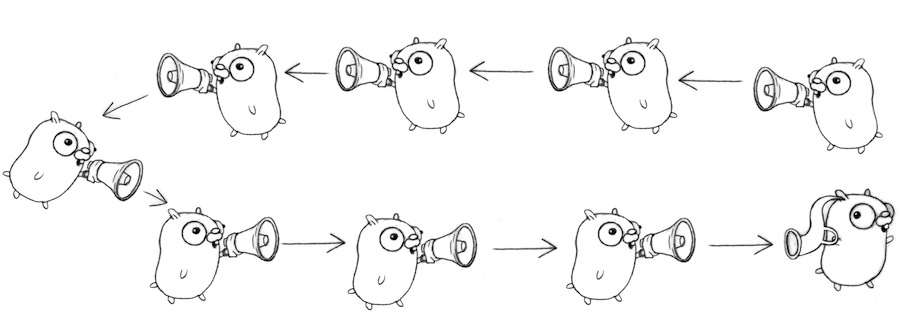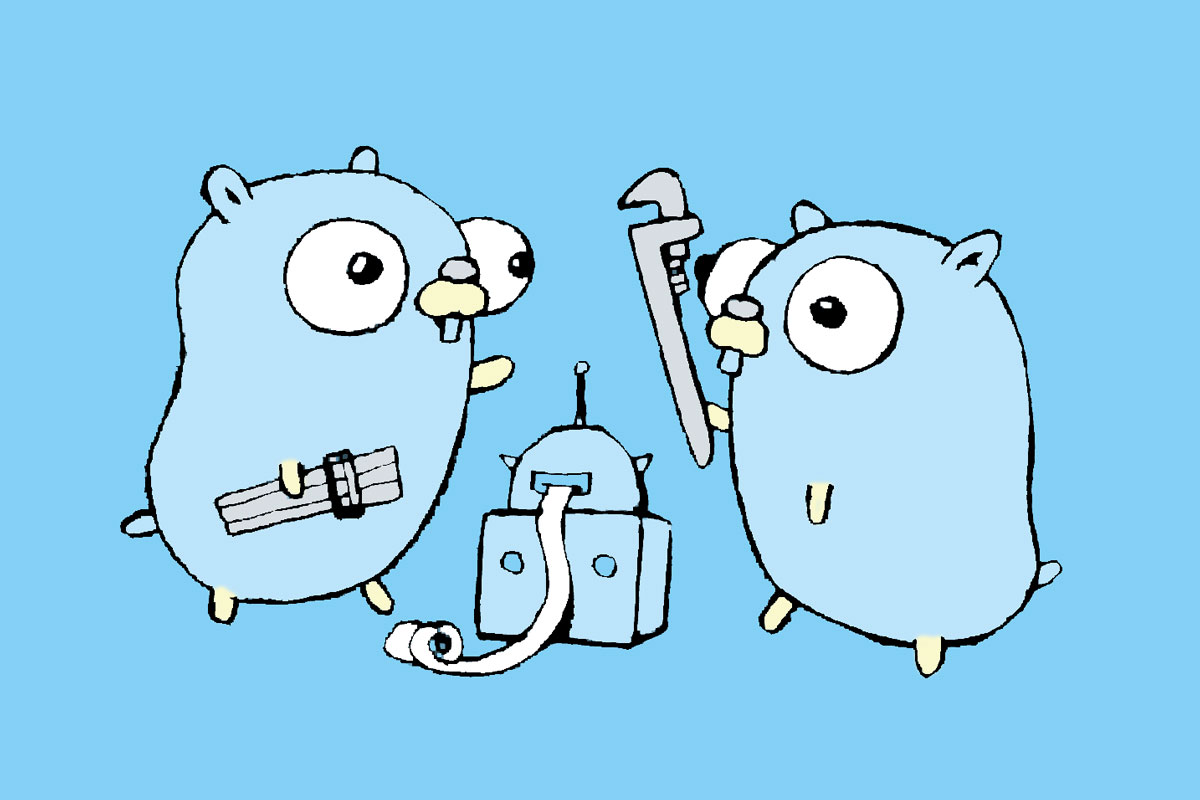Exploring Go's objects
Exploring details on how objects are implemented in Go

I started to understand Go’s object model easier when I accepted that there is no objects at all, there is just sets of functions that can operate on common state, with some sugar sprinkled on top.
Perhaps you are thinking “shut up, of course there are objects in Go” or “sets of functions that operates on common state is the definition of an object”, well, you are probably right.
I can’t see a difference between a set of related functions operating on the same state and an object, at least thinking on the objects that I’m used to. And there is more to Go object model than syntactic sugar (I was kinda pushing the idea to an extreme :-)).
But it is an object model very different from the classical ones, like Java, C++ and Python (these are the ones I know at least).
When struggling to get a sense of how Go objects works it helped me a lot to just let go of my traditional object notion and think only in terms of functions.
What I’m going to try is to de-construct the object model to just functions and build it back to how Go works, showing that Go is much more prone to functions with objects as an aid to make some idiom’s easier than an object oriented language where everything is an object.
It will probably be a lousy de-construction since I’m not an expert in Go, but yet I feel compelled to try, since it looks like fun :-).
In the beginning there was the functions
Well I’m trying to make a point around thinking first about functions, so here goes a stupid example of what can be done with functions.
Lets define a type that is actually a function:
type Adder func(int, int) int
You can think about it as an interface (but it is not the same thing). Any function that matches the signature will be acceptable as being of the type Adder:
// Same type as Adder
func add(a int, b int) int {
return a + b
}
An abstract adder that does not know how to add:
func abstractedAdd(a Adder, b int, c int) int {
return a(b, c)
}
This really recalls the kind of thing you can do with interfaces. abstractedAdd does not know how to add, and it will accept any implementation of an Adder that respects the same protocol.
Given this extremely useless and simple example, here is the full working code:
package main
import "fmt"
type Adder func(int, int) int
// Same type as Adder
func add(a int, b int) int {
return a + b
}
func abstractedAdd(a Adder, b int, c int) int {
return a(b, c)
}
func main() {
var a Adder
fmt.Printf("Adder: %v\n", a)
a = add
fmt.Printf("Adder initialized: %v\n", a)
fmt.Printf("%d + %d = %d\n", 1, 1, abstractedAdd(a, 1, 1))
fmt.Printf("%d + %d = %d\n", 1, 1, abstractedAdd(add, 1, 1))
}
With this example in mind we have the opportunity to start exploring Go’s objects. Can a method satisfy the Adder type ? Depending on your background this may sound counter intuitive (something like, one is a method, but you need a function, etc) lets take a look at an adder object:
type ObjectAdder struct{}
func (o *ObjectAdder) Add(a int, b int) int {
return a + b
}
Sound about right, adding it on our example:
package main
import "fmt"
type Adder func(int, int) int
func add(a int, b int) int {
return a + b
}
func abstractedAdd(a Adder, b int, c int) int {
return a(b, c)
}
type ObjectAdder struct{}
func (o *ObjectAdder) Add(a int, b int) int {
return a + b
}
func main() {
var a Adder
fmt.Printf("Adder: %v\n", a)
a = add
fmt.Printf("Adder initialized: %v\n", a)
fmt.Printf("func: %d + %d = %d\n", 1, 1, abstractedAdd(a, 1, 1))
fmt.Printf("func: %d + %d = %d\n", 1, 1, abstractedAdd(add, 1, 1))
var o *ObjectAdder
fmt.Printf("object: %d + %d = %d\n", 1, 1, abstractedAdd(o.Add, 1, 1))
}
Result:
Adder: <nil>
Adder initialized: 0x401000
func: 1 + 1 = 2
func: 1 + 1 = 2
object: 1 + 1 = 2
Yep, it worked. Differently from interfaces, the function signature will not match any kind of method name, you just pass the method as a parameter, since the method is actually just a function, it could be something like:
var o *ObjectAdder
fmt.Printf("object: %d + %d = %d\n", 1, 1, abstractedAdd(o.Whatever, 1, 1))
Should work just fine. Not convinced that the method is just a function ? Let’s add this:
fmt.Printf("func add: %T\n", add)
fmt.Printf("object.Add: %T\n", o.Add)
Result:
func add: func(int, int) int
object.Add: func(int, int) int
Do you see any difference on the type of the free function and the object method ? No ? It’s because there is none. That is why passing it as the parameter worked. This also explains another thing going on in this code that sometimes makes newcomers (like me) to Go confused.
There is no fully initialized ObjectAdder on our example. I used a pointer by purpose, as you can see the pointer is not initialized at all (it is nil), yet it worked. In any other object oriented language that I know this would never work, but in Go it worked, why ?
Well because in Go, there is no methods at all, there is no method type, methods are actually syntactic sugar for calling functions passing an instance of the type as the first parameter (as people are used to do in C). In Go this first parameter is usually called the method receiver, but there is nothing special about it, it is just a parameter being passed to a function.
Lets elaborate our example:
fmt.Printf("ObjectAdder.Add: %T\n", (*ObjectAdder).Add)
fmt.Printf("ObjectAdder.Add: %d + %d = %d\n", 1, 1, (*ObjectAdder).Add(nil, 1, 1))
What I’m doing here ? Just making it explicit what Go actually does when you declare something like:
type ObjectAdder struct{}
func (o *ObjectAdder) Add(a int, b int) int {
}
It will add a function on the type *ObjectAdder. This function is accessible and can be used as any other value on the language (being called, passed as a parameter, etc).
If you are thinking “hey, but the type is ObjectAdder not *ObjectAdder”, well in Go the pointer counter part of a type is actually another type and has even a different set of functions appended to it. To which of the types the function will be added is decided by the type of the method receiver, on this case it is a (*ObjectAdder).
This relates to the method sets concept introduced by Go.
Anyway, going on, the result:
ObjectAdder.Add: func(*main.ObjectAdder, int, int) int
ObjectAdder.Add: 1 + 1 = 2
There is no method at all, it is just a function. What we see as an object in Go is actually a collection of functions associated to a type and syntactic sugar to pass the first argument for you.
Which to be honest is like almost all object oriented languages is actually implemented. The good thing is that in Go this is 100% explicit, no magic, just some syntactic sugar. Go is really serious about being explicit.
This makes a lot of things more simple and uniform, the examples showed that. Passing a function or a method as an argument has no difference at all (I can’t think on a reason to exist a difference).
Here is the full code of the final example:
package main
import "fmt"
type Adder func(int, int) int
// Same type as Adder
func add(a int, b int) int {
return a + b
}
func abstractedAdd(a Adder, b int, c int) int {
return a(b, c)
}
type ObjectAdder struct{}
func (o *ObjectAdder) Add(a int, b int) int {
return a + b
}
func main() {
var a Adder
fmt.Printf("Adder: %v\n", a)
a = add
fmt.Printf("Adder initialized: %v\n", a)
fmt.Printf("func: %d + %d = %d\n", 1, 1, abstractedAdd(a, 1, 1))
fmt.Printf("func: %d + %d = %d\n", 1, 1, abstractedAdd(add, 1, 1))
var o *ObjectAdder
fmt.Printf("func add: %T\n", add)
fmt.Printf("object.Add: %T\n", o.Add)
fmt.Printf("object: %d + %d = %d\n", 1, 1, abstractedAdd(o.Add, 1, 1))
fmt.Printf("ObjectAdder.Add: %T\n", (*ObjectAdder).Add)
fmt.Printf("ObjectAdder.Add: %d + %d = %d\n", 1, 1, (*ObjectAdder).Add(nil, 1, 1))
}
This example is completely stateless. Objects usually have state and side effects,can Go functions have state and side effects too ?
Functions and state
To make the gap between functions and objects even smaller lets work with the oldest/simplest example, an iterator:
package main
import "fmt"
func iterator() func() int {
a := 0
return func() int {
a++
return a
}
}
func main() {
iter := iterator()
fmt.Printf("iter 1: %d\n", iter())
fmt.Printf("iter 2: %d\n", iter())
fmt.Printf("iter 3: %d\n", iter())
}
If you run this you will see that it is a valid iterator. What we have here exactly ? We have a iterator function that acts as a constructor for another function, that will be returned, that is why the return type of iterator is:
func() int
What is usually referred as closure is this lexical construction:
a := 0
return func() int {
a++
return a
}
The function that we are instantiating access a variable that exists on the outer scope, this will associate the a variable to the newly created function, it has a reference to a and can manipulate it.
This is a mind bender if you are used to only use objects as a mean to managing state (actually it is odd to most C programmers too, since functions are a static construction in C).
In Go, functions are instantiated all the time, here goes another version of this example that makes it explicit that we are actually instantiating functions:
package main
import "fmt"
func iterator() func() int {
a := 0
return func() int {
a++
return a
}
}
func main() {
itera := iterator()
iterb := iterator()
fmt.Printf("itera 1: %d\n", itera())
fmt.Printf("itera 2: %d\n", itera())
fmt.Printf("itera 3: %d\n", itera())
fmt.Printf("iterb 1: %d\n", iterb())
fmt.Printf("iterb 2: %d\n", iterb())
fmt.Printf("iterb 3: %d\n", iterb())
}
We get:
itera 1: 1
itera 2: 2
itera 3: 3
iterb 1: 1
iterb 2: 2
iterb 3: 3
So each iterator is completely isolated from each other and there is no way for one function to access state from the other, unless it is explicitly allowed lexically on the code, or you do some really bad ass pointer arithmetic using the unsafe package.
This is fun, since languages like Lisp have closures since ever and this provides the absolute maximum level of encapsulation you can imagine. There is no way to access the state directly except through the function.
Lets take a look on how this would look like using a Go object:
package main
import "fmt"
type iterator struct {
a int
}
func (i *iterator) iter() int {
i.a++
return i.a
}
func newIter() *iterator {
return &iterator{
a: 0,
}
}
func main() {
i := newIter()
fmt.Printf("iter 1: %d\n", i.iter())
fmt.Printf("iter 2: %d\n", i.iter())
fmt.Printf("iter 3: %d\n", i.iter())
}
As you can see, for something very simple the object way seems a little more clumsy, at least it looks like it to me. I even gave the same lousy name a to the integer, that is actually the state.
Here you create a struct to hold the state, add a function to the type, and use that function to manipulate the state.
If you are feeling fancy, you can do this in Go without an struct at all:
package main
import "fmt"
type iterator int
func (i *iterator) iter() int {
*i++
return int(*i)
}
func main() {
var i iterator
fmt.Printf("iter 1: %d\n", i.iter())
fmt.Printf("iter 2: %d\n", i.iter())
fmt.Printf("iter 3: %d\n", i.iter())
}
The function version did the same thing, on a different way. And it was able to manage state just as an object would, with lexical scoping to guarantee state isolation, just the function is able to change the state.
To finish this argument, lets develop a set of functions that operates on shared state (that is pretty much the work an object does):
package main
import "fmt"
type stateChanger func() int
func new() (stateChanger, stateChanger) {
a := 0
return func() int {
a++
return a
},
func() int {
a--
return a
}
}
func main() {
inc, dec := new()
fmt.Printf("inc 1: %d\n", inc())
fmt.Printf("inc 2: %d\n", inc())
fmt.Printf("inc 3: %d\n", inc())
fmt.Printf("dec 1: %d\n", dec())
fmt.Printf("dec 2: %d\n", dec())
fmt.Printf("dec 3: %d\n", dec())
}
The output:
inc 1: 1
inc 2: 2
inc 3: 3
dec 1: 2
dec 2: 1
dec 3: 0
As can be seen clearly, both functions share the same common state and can manipulate it, just as you would do with an object with two methods.
Of course I’m not advocating that you should just play around with a bunch of variables holding functions, structs exist exactly to give name and meaning to a composition of other types.
The same applies to functions, just having a lot of loose functions would be a mess on a lot of cases (just as is with data).
Since Go does have functions as first class citizens, a struct could have some fields that holds functions, emulating the behaviour of methods, and representing a set of functions that operates on common state. But that would be clumsy and error prone, like the possibility of a non initialized field/method being called (anyone that have programmed in C will understand this problem very well, and its consequences).
A working calculator:
package main
import "fmt"
type Calculator struct {
Add func(int,int) int
Sub func(int,int) int
}
func newCalculator() Calculator {
return Calculator{
Add: func(a int, b int) int {
return a + b
},
Sub: func(a int, b int) int {
return a - b
},
}
}
func main() {
calc := newCalculator()
fmt.Println(calc.Add(3, 2))
fmt.Println(calc.Sub(3, 2))
}
Well, you could argue about the clumsiness, depending on your background this may seem better than the way Go expresses methods. But you can’t argue about the space this gives to error’s.
For example, this:
package main
import "fmt"
type Calculator struct {
Add func(int,int) int
Sub func(int,int) int
}
func newCalculator() Calculator {
return Calculator{
Add: func(a int, b int) int {
return a + b
},
Sub: func(a int, b int) int {
return a - b
},
}
}
func main() {
var calc Calculator
fmt.Println(calc.Add(3, 2))
fmt.Println(calc.Sub(3, 2))
}
Will result in:
panic: runtime error: invalid memory address or nil pointer dereference
[signal SIGSEGV: segmentation violation code=0xffffffff addr=0x0 pc=0xc64e8]
goroutine 1 [running]:
main.main()
/tmp/sandbox772959961/main.go:23 +0x28
Even tough this is also possible to happen with methods, the feature of adding functions to a type gives a compile time safe way to represent a set of functions that operate on the same type. At least the call to the method is always safe (although you may have a invalid method receiver that will crash your program).
Besides clumsiness and error proneness there is also the problem of how to express abstractions that are more complex than a single function.
Abstracting
All our abstractions until now consisted of something that could be expressed with just one function, but what can you do when the abstraction requires more than one function ?
If there is no way to express this you would always have to conflate your abstractions in one function, that would look just horrible (think about a read/write abstraction modeled on just one function).
The calculator example above provided a way to simulate methods to a level that someone looking at how the Calculator is used would be unable to tell that it’s methods are not methods at all.
But there is a very important concept missing, a concept where Go’s methods are fundamental, how you express that you require a set of functions without defining who will implement them and how it will be implemented ?
To complete it, given a function X, that requires a set of functions Y, how would you syntactically express that a type Z implements the required set of functions Y, hence being a viable choice to integrate with the function X ?
One way to solve this is with safe polymorphism. I want to be able to have multiple different implementations of the same set of functions that can interoperate seamlessly. There is emphasis on the safe part of polymorphism. I had my share of C polymorphism, it is possible and works very well, but it is definitely not safe. You could argue that no implementation is completely safe, but safer than C would be the basic, and it is what most languages like Java and Python delivered on the time they where developed.
Safe is important because the calculator example could be used to implement a form of this. We could do this:
type Calculator struct {
Add func(int,int) int
Sub func(int,int) int
}
func codeThatDependsOnCalculator(c Calculator) {
// etc
}
This would allow for N different implementations of a Calculator to integrate with the code that depends on it, but it would not be safe. It is very easy to provide just half the implementation and get away with it. All functions that accept a Calculator would need to check if Add and Sub are not nil.
This is awfully a lot alike how this is usually implemented in C, and is clearly job that a compiler can do for you (in C you can use some macros).
The answer Go have for this is interfaces, which is in my opinion the most awesome feature of Go.
Since this post is already very long, the evolution of the ideas to interfaces will be made on a subsequent post.
Happy Go hacking ;-).
Acknowledgments
Special thanks to:
For taking time reviewing and pointing out a lot of stupid mistakes.






Share this post
Twitter
Google+
Facebook
Reddit
LinkedIn
StumbleUpon
Pinterest
Email